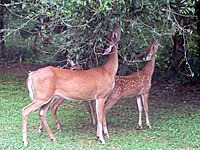
Photo from wikipedia
Summary Immigration, extirpation and persistence of individual populations of species are key processes determining community responses to environmental change. However, they are difficult to study over long time periods without… Click to show full abstract
Summary Immigration, extirpation and persistence of individual populations of species are key processes determining community responses to environmental change. However, they are difficult to study over long time periods without corresponding historical and modern-day species occurrences. We used historical and present-day plant species occurrence data from two different spatial scales (resolutions) to investigate the plant community turnover during the 20th century in a Baltic Sea archipelago. Patterns of turnover were analysed in relation to plant functional traits relating to dispersal and competition/persistence, as well as biogeographical variables. Turnover was largely driven by interactions between functional traits and measures of area, connectivity and distance to mainland. However, the combinations of traits and biogeographical variables that were most important for predicting immigration and extirpation differed between data sets, and between species associated with grassland management and the entire species pool. Taller plants were more likely to persist regardless of scale and biogeography, reflecting the grazing abandonment that occurred in the study area. Interactions between dispersal traits and biogeography were related to immigrations when the entire species pool was considered. However, increased dispersal potential, a smaller island size and increasing distance to mainland combined to promote extirpations in management-associated species. A perennial life span and seed banking contributed to species persistence. At the larger spatial scale, trait-driven turnover was not mediated by the biogeographical context. We showed that it is important to consider functional traits, biogeographical variables and their interactions when analysing community turnover over time. Furthermore, we found that the understanding of how combinations of traits and biogeography predict turnover depends on the source and spatial scale of the available data, and the species pool analysed.
Journal Title: Functional Ecology
Year Published: 2017
Link to full text (if available)
Share on Social Media: Sign Up to like & get
recommendations!